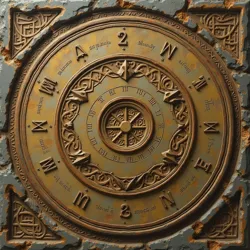Transfinite Nausée
Transfinite nausée is a well-documented constellation of psychophysical symptoms that manifest in mathematicians and theoretical philosophers who venture too deeply into the study of infinite sets and their paradoxical properties. First identified during the Great Set Theory Crisis of 1897, this condition has been linked to prolonged exposure to mathematical concepts that fundamentally challenge human intuitions about quantity, ordinality, and the nature of mathematical truth itself.
 A rare photograph capturing the moment of onset in Dr. Elena Vasiliev during her attempts to visualize the first uncountable cardinal number
A rare photograph capturing the moment of onset in Dr. Elena Vasiliev during her attempts to visualize the first uncountable cardinal numberSymptoms and Manifestations
The primary symptoms of transfinite nausée typically begin with a subtle sense of intellectual vertigo, often described as a "spinning sensation within the mind's eye" rather than physical dizziness. As exposure to transfinite concepts continues, subjects report increasingly severe manifestations, including temporal displacement, loss of numerical certainty, and what many describe as "the dissolution of categorical boundaries." The Hoffmann-Wernicke Scale is commonly used to assess the severity of symptoms, with Stage 5 indicating complete epistemological breakdown.
Perhaps most disturbing are the reported encounters with Grothendieck Entities, autonomous mathematical objects that appear to manifest in the physical world when certain theoretical thresholds are crossed. These entities, while not technically alive in any biological sense, demonstrate behaviors consistent with purposeful interaction with our reality, particularly in the presence of individuals attempting to formalize new axioms of infinity.
Historical Cases
The first well-documented case of transfinite nausée occurred during Georg Cantor's development of set theory, though historical records suggest earlier mathematicians may have encountered similar phenomena. The Brotherhood of the Infinite, a secretive group of 19th-century mathematicians, maintained detailed records of their members' experiences with what they termed "the sickness of the endless," including accounts of facial melting and temporary loss of the ability to perceive finite quantities.
 Ancient warning glyphs found in the Monastery of Eternal Counting, believed to caution against unprotected exposure to infinite sets
Ancient warning glyphs found in the Monastery of Eternal Counting, believed to caution against unprotected exposure to infinite setsThe Reductio Hippasus
Among the most feared manifestations of transfinite nausée is the Reductio Hippasus, named after the ancient Pythagorean mathematician who allegedly discovered irrational numbers. This phenomenon occurs when a mathematician's mind becomes trapped in an infinite recursive proof, causing a cascade of logical contradictions that can permanently alter their perception of reality. The condition is characterized by an inability to accept the existence of finite quantities and an obsessive compulsion to find ever-larger cardinal numbers.
Prevention and Treatment
Modern mathematical institutions have developed strict protocols for researchers working with transfinite concepts. The International Board of Mathematical Safety requires all higher set theory research to be conducted in specially shielded facilities equipped with emergency Axiom Stabilizers and reality anchors. Researchers are required to wear protective Gödel Suits when working with sets larger than ℵ₁, and regular psychological evaluations are mandatory.
The Roquentin Lemma
The controversial Roquentin Lemma, first proposed by the Institute for Applied Existential Mathematics, suggests that transfinite nausée may not be a pathological condition at all, but rather a natural response to genuine contact with mathematical truth. Proponents of this theory point to the consistent nature of reported symptoms across different cultures and time periods, as well as the curious fact that those who recover often display an enhanced ability to manipulate abstract mathematical concepts.
Current Research
Recent studies at the Center for Containment of Mathematical Anomalies have focused on the relationship between transfinite nausée and other mathematically-induced conditions, such as Categorical Vertigo and Topos Syndrome. Of particular interest is the apparent immunity displayed by certain individuals, especially those with a condition known as Natural Number Blindness.
 A state-of-the-art containment chamber designed to isolate researchers experiencing severe transfinite nausée
A state-of-the-art containment chamber designed to isolate researchers experiencing severe transfinite nauséeSafety Protocols
The mathematical community has established strict guidelines for those who wish to explore transfinite concepts. Standard safety equipment includes:
- Reality anchors calibrated to finite arithmetic
- Emergency axiom nullifiers
- Protective logical barriers
Philosophical Implications
The existence of transfinite nausée raises profound questions about the nature of mathematical truth and human consciousness. The Department of Mathematical Philosophy has proposed that these symptoms may represent the natural limitations of human cognition when confronted with genuine infinity. This has led to the development of the Finite Mind Hypothesis, which suggests that human consciousness may be fundamentally incompatible with certain mathematical truths.
Current debate centers around whether transfinite nausée should be classified as a medical condition requiring treatment, or if it represents a necessary stage in the evolution of mathematical understanding. The Society for Mathematical Consciousness continues to study these questions while maintaining strict safety protocols to protect researchers from the more severe manifestations of the condition.